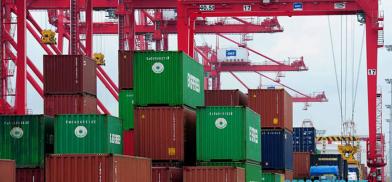Sri Lanka GDP could contract 4% in 2020
Sri Lanka’s economy could contract up to 4 percent in 2020 and the budget deficit could expand to as much as 11 percent gross domestic with import controls amplifying the impact of coronavirus on revenues, analysts said

Sri Lanka’s economy could contract up to 4 percent in 2020 and the budget deficit could expand to as much as 11 percent gross domestic with import controls amplifying the impact of coronavirus on revenues, analysts said.
Sri Lanka’s manufacturing activity has rebounded strongly by June according to a Purchasing Managers Index compiled by the central bank, while the services recovery is weak, with tourism down and people still wary of traveling and congregating.
The import lockdown may also be hitting services. The central bank has said it will revise its forecast for 2020 after first-quarter data is out, but is expecting a contraction in the second quarter.
The International Monetary Fund initially forecasted a 0.5 percent contraction for Sri Lanka in April 2020, when emerging and developing Asia was expected to grow 1 percent which was downgraded by 1.8 percent in June to a contraction of 0.8 percent.
Global economic output was downgraded by 1.9 percent to a contraction of 4.9 percent in June from 3.0 percent in April. Fitch Ratings is forecasting a 1.3 percent contraction for 2020.
GDP Contraction
“Our base case scenario as of now forecasts Gross Domestic Product (GDP) to contract by about 4 to 4.5 percent this year,” Lakshini Fernando, Vice President at Asia Securities, a Colombo-based brokerage speaking at an online forum organized by Echelon Magazine.
“We also took in to account the fact that airports are closed so the services sector will have a significant multiplier effect running through.
“On the external side, we looked at how global slowdown will affect the manufacturing sector yet again a negative multiplier effect.
“We initially forecasted the entire pandemic and the overall lockdown to naturally start easing by the end of May which played its part naturally.
“However, there was a scare of a second wave but what we see is if the government can control with minimal lockdowns, continuing economic activities at 50-60 percent, you will see activity continue to some extent.”
Fernando forecasts the industrial sector to contract by 19-22 percent in the second quarter and 5.5-7 percent by the third quarter. The Services sector is expected to contract by 9-11 percent, she said. For the full year, the industrial sector is expected to contract by 5.8-6.2 percent and the services sector to contract by 1.3 to 1.8 percent.
“Initially we expected the base case scenario to be at a 3 percent GDP contraction in 2020 and recover to a U level in 2022,” Nikita Tissera, Head of Research at Bartleet Religare Securities said.
“However given the current scenario and the fears of a second wave, we have to increase the forecast to about 4 percent marginally”.
He says even though Sri Lanka has 2700 plus COVID-19 cases, the fact that they are from specific clusters works positively for the country.
“We really don’t believe that we will go in for another lockdown because we will have the impact of it and the society is also mature enough to handle it,” Tissera said.”We could face it if there was a second wave after the election.”
So-called Second Waves are found in countries that did not kill the Chinese or Wuhan wave in January and February, which is most of Europe, the Americas where the infection trees have a large number of levels.
Clusters in Singapore and Korea also date back from the Wuhan Wave. Sri Lanka’s clusters date back from March 2020, and also from testing gaps, where those released from quarantined are not tested in week three and four.
“We are looking at Negative GDP growth of around 2-3 percent this year,” Udeeshan Jonas, Senior Vice President – Head of Research at Capital Alliance said.
“But it has not been a V-shaped recovery as what we would have liked to be. It is rather a U or W shaped recovery”.
First Capital’s Dimantha Mathew expects GDP growth to contract -1.4 percent in 2020
“For the second and third quarter we are looking at -7 percent and -3 percent GDP growth,” he said. “Full-year GDP growth outlook will be -1.4 percent with the 4th quarter having a positive GDP growth”.
CTLSA Securities is forecasting a 2 percent contraction, with tourism, consumption, and construction expected to be weak.
Budget Deficit Driven by Import Controls
The budget deficit for 2020 could rise as much as 11 percent as import controls hit tax revenues analysts said.
“On the deficit, I believe we will have a 10-11 percent deficit this year,” Tissera said. “Forty-nine percent of the government’s tax revenue comes from imports.
“So, the lack of imports would continue to weigh in heavily on lack of revenue, so I foresee 11 percent of a deficit on GDP for this year.”
Sri Lanka imposed sweeping import bans until July 2020 after unprecedented money printing triggered foreign exchange shortages. The controls have since been extended.
Up to 240 billion rupees of excess liquidity has gone out of the system in forex reserve sales (sale of foreign assets) to importers and the Treasury, official data show.
The central bank is now also ‘unprinting’ selling down Treasury bills (domestic assets) and terminating reverse repo deal to withdraw liquidity before it hits the forex market.
“I am expecting around 10 percent budget deficit which means debt to GDP of 82 percent of last year-end will go up to slightly above 90 percent (in 2020),” Executive Director, Research/Strategist at CT CLSA Securities, Sanjeewa Fernando said.
“That’s a bad number as a country.”
“Our debt to GDP is pretty high, total debt to GDP as at end last year is 89 percent,” Mathew said. “But with the new interest coming and the rollover of those debts, I’m sure we are going to go well above 90 percent somewhere close to 95 to 96”.
However, analysts said the likelihood of sovereign default was low.
Fernando said the government has shown tight spending controls for the first few months of the year, slashing capital spending, which will help keep the deficit.
Analysts said Sri Lanka will have to do hard reforms under an expected International Monetary Fund program to get economic activity moving and avoid external sovereign default.
Credit Growth and Interest Rates
Private credit growth for 2020 would be low or negative, analysts said keeping a lid on interest rates, despite the worsening deficit.
A further policy interest rate cut was also a possibility.
“If we take credit growth in line with GDP… we are still going on a 0 to -1.5 percent credit growth figure,” Mathew said.
“If we look at interest rates, on the yield curve we feel that bond rates have bottomed out,” Mathew said.
“However there is a possibility that at least there is room for another monetary policy easing rate cut in the range of 50 basis points.
“But we feel that the yield curve has already been adjusted for that 50 basis points as well. If that’s not given then the market may be disappointed.
“But in addition to that though we feel interest rates have bottomed out, we don’t feel that there is likely to be an immediate uptrend due to the lack of demand and credit in the system.
“So, with that, we don’t see any sort of pressure coming in until the 4th quarter of this year. The only issue is if the liquidity comes down further. Otherwise, we feel that the interest rates can remain at these levels.”
Sri Lanka’s last policy rate cut did not involve injecting money more through open market operations to enforce. It simply solved the problem of having a too-narrow policy corridor by lowering the floor rate amid weak overall credit.
To stop foreign exchange problems and maintain monetary stability, analysts have called for a wider policy corridor and a halt to call money rate targeting, which is incompatible with targeting the exchange rate or allowing external flows.
When the call money rate is targeted with excess money in a monetary stimulus, exchange controls, and in Sri Lanka’s case import controls also is the inevitable outcome, which is known as the impossible trinity of monetary policy objectives.
Data showed that total credit in June was only 78 billion rupees and private credit was negative was in both May and June.
Tissera says the market has room for 100 basis point rate cut for both lending and benchmark rates.
“This is the highest liquidity we have seen in the banking sector historically, still the loan book isn’t growing,” he said. “I think interest rates weren’t a factor for loan book growth at all. Lack of growth in the loan book is a factor of low demand.
“I foresee another 100 basis points drop in the benchmark rates in the next 12 months and I believe this could happen across the yield curve and I think the yield curve could possibly see a downward shift.”
Jonas from Capital Alliance said amid weak credit growth money is flowing into financial markets and is pushing down yields.
“We believe that this interest rate environment could continue hence we believe that the rates could come down by another 70-80 basis points,” he said.
Sri Lanka’s stocks have also risen despite bad earnings. Foreign investors however are exiting amid the liquidity.
Exchange rate
Sri Lanka rupee fell close to 200 to the US dollars as money was printed in March but has since been allowed to appreciate to 185 to the US dollar. Amid suspected real effective exchange rate targeting the central bank is buying dollars at 185 instead of allowing it to appreciate it back to 182 to the US dollar.
Sri Lanka’s central bank has the worst record among central banks in South Asia, whose monetary units are derived from the Indian rupee at around 4.70 to the US dollar at self-determination from British rupee.
Pakistan has the second-worst record and Maldives Monetary Authority has the best with the country now having 11000 dollars per capita income with long periods of economic stability and free trade.
Analysts expect the rupee to trade between 185 to 190 to the US dollar this year, but it could weaken later.
“Exchange rates may comfortably remain 195 rupees to the dollar because of import controls,” Jonas said.
“But next year the scenario might be different in terms of the exchange rate, there could be higher depreciation once import controls are removed.
“And if the liquidity is not absorbed from the system then we might see that flowing into imports which might effectively drag rupee a little bit more,” Jonas said.
“I believe Sri Lanka will continue to protect the currency,” Tissera said. “I think the imports will continue to be curtailed for a little longer than we like and it will probably be one way of us preserving currency to be able to maintain our interest payments.”
“I’m not placing a lot of stress on the rupee in the short term – let’s say in the next 18 months – it will be in the 190-192 rupees against the US dollar.”
Classical analysts have said as long the overnight interbank rate is near the floor rate and no money is injected to keep it in the middle of the corridor (sterilization in excess of 100 percent) or under the policy ceiling (100 percent sterilization only) there is no pressure on the rupee peg.
https://economynext.com/sri-lanka-gdp-could-contract-4-pct-in-2020-import-controls-may-drive-deficit-to-11-pct-analysts-72395/#









Post a Comment